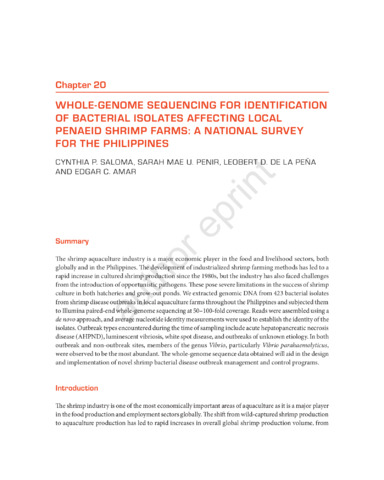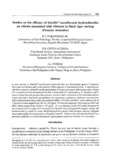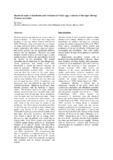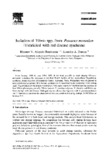Whole-genome sequencing for identification of bacterial isolates affecting local penaeid shrimp farms: A national survey for the Philippines
- Global styles
- MLA
- Vancouver
- Elsevier - Harvard
- APA
- Help

ดู/
วันที่
2022Page views
1,024ASFA keyword
AGROVOC keyword
Taxonomic term
เมตาดาต้า
แสดงระเบียนรายการเต็ม
Share
นามธรรม
The shrimp aquaculture industry is a major economic player in the food and livelihood sectors, both globally and in the Philippines. The development of industrialized shrimp farming methods has led to a rapid increase in cultured shrimp production since the 1980s, but the industry has also faced challenges from the introduction of opportunistic pathogens. These pose severe limitations in the success of shrimp culture in both hatcheries and grow-out ponds. We extracted genomic DNA from 423 bacterial isolates from shrimp disease outbreaks in local aquaculture farms throughout the Philippines and subjected them to Illumina paired-end whole-genome sequencing at 50–100-fold coverage. Reads were assembled using a de novo approach, and average nucleotide identity measurements were used to establish the identity of the isolates. Outbreak types encountered during the time of sampling include acute hepatopancreatic necrosis disease (AHPND), luminescent vibriosis, white spot disease, and outbreaks of unknown etiology. In both outbreak and non-outbreak sites, members of the genus Vibrio, particularly Vibrio parahaemolyticus, were observed to be the most abundant. The whole-genome sequence data obtained will aid in the design and implementation of novel shrimp bacterial disease outbreak management and control programs.
การอ้างอิง
Saloma, C. P., Penir, S. M. U., de la Peña, L. D., & Amar, E. C. (2022). Whole-genome sequencing for identification of bacterial isolates affecting local penaeid shrimp farms: A national survey for the Philippines. In V. Alday-Sanz (Ed.), The Shrimp Book II (pp. 485–497). 5M Books Ltd.
Type
Book chapterISBN
9781789181043คอลเลกชัน
- Books and Book Chapters [123]
Related items
Showing items related by title, author, creator and subject.
-
Studies on the efficacy of Sarafin® (sarafloxacin hydrochloride) on vibrios associated with vibriosis in black tiger shrimp (Penaeus monodon)
Pakingking, Rolando V., Jr. ; Lacierda, Erlinda; Torres, James L. (Fish Health Section, Asian Fisheries Society, 2002)
In vitro activity of Sarafin® (sarafloxacin hydrochloride) was determined against 7 luminous Vibrio harveyi isolates and 3 non-luminous Vibrio species (V. parahaemolyticus, V. alginolyticus and Vibrio species) isolated ...
; Lacierda, Erlinda; Torres, James L. (Fish Health Section, Asian Fisheries Society, 2002)
In vitro activity of Sarafin® (sarafloxacin hydrochloride) was determined against 7 luminous Vibrio harveyi isolates and 3 non-luminous Vibrio species (V. parahaemolyticus, V. alginolyticus and Vibrio species) isolated ... -
Bacterial loads in hatcheries and virulence of Vibrio spp. to larvae of the tiger shrimp Penaeus monodon
Torres, James L. (Bureau of Agricultural Research, Department of Agriculture, 2007)Shrimp hatcheries are high-density systems and are prone to diseases. A small-scale and a large-scale hatchery for the tiger shrimp Penaeus monodon in Iloilo, Philippines were monitored over two months for water quality ... -
Isolation of Vibrio spp. from Penaeus monodon (Fabricius) with red disease syndrome
From January 1990 to June 1993, 59% of the total juvenile to adult shrimp Penaeus monodon submitted for diagnosis at the Fish Health Section of the Aquaculture Department, Southeast Asian Fisheries Development Center, ...





